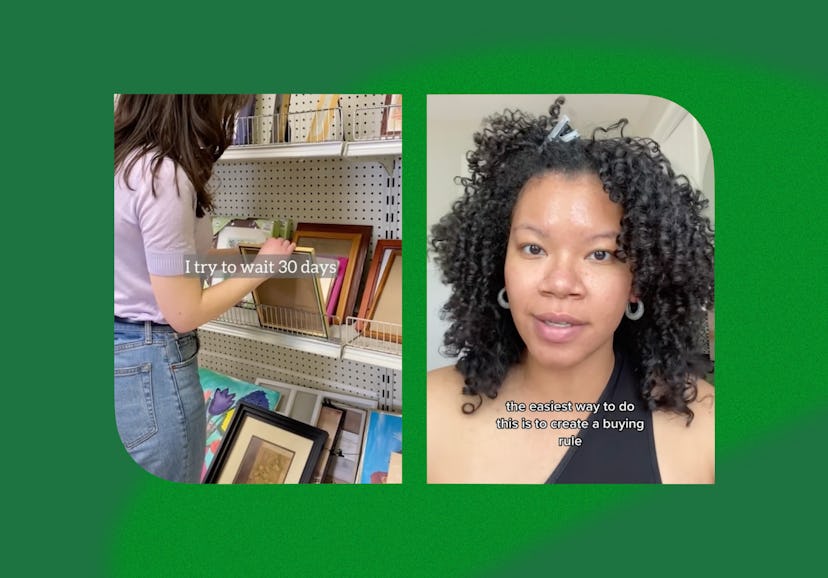Money
Try The “30-Day Rule” Money-Saving Hack To Stop Impulse Buys
Starting small can help you save big.
Picture it. You’re scrolling TikTok late one night when you see an influencer wearing what appears to be the world’s most perfect shirt. It’s cute, the video is going viral, and suddenly, you feel the urge to snap it up before it sells out. In the blink of an eye, you’ve made a purchase that wasn’t in your budget.
The same thing might happen when you’re out shopping IRL and see something that feels like a must-have, even though you didn’t know it existed five minutes ago. Since it’s so easy to make unnecessary purchases like these, many people practice the 30-day spending rule, a trick that’s currently going viral on TikTok.
The 30-day rule is a savings hack where you wait a month before making a purchase versus buying it in the heat of the moment. The idea is that you’ll either forget about it by then or decide you don’t want it anymore once the excitement has passed. If you’re still thinking about the item 30 days later, it may be a sign that you actually do want it, and that’s when you can treat yourself.
On the app, creator @goingzerowaste_ says she uses the 30-day rule to save money and stick to a budget, while creator @theblendedbeauty follows a similar buying rule to prevent overconsumption. Keep scrolling to find out why the 30-day rule works like a charm, according to a financial expert.
The Benefits Of The 30-Day Rule
According to Lauren Fischer, CFP, CAIA, a certified financial planner and co-founder at Team Fischer Financial, the 30-day rule encourages you to wait 30 days before buying something "non-essential,” like clothes, books, perfumes, etc. If you often overspend or buy things you don’t need, then this hack might be a good one to follow.
The reason why it works so well is because it forces you to slow down and think about how you’re spending your money, Fischer says. If you’re trying to save cash or stick to a budget, adopting a spending rule like this one will help you be a little more mindful.
“It also cuts down on emotionally-driven spending that may feel really great in the moment but isn't the best choice to help you save money,” she says. With 24/7 access to online stores, it’s so easy to hit “add to cart” followed by a quick “purchase.” Add in the fear that an item will sell out, and it’s why it’s so common to snag it in a panic before processing whether or not you even want it.
“With the 30-day rule, instead of buying instantly, you wait 30 days and decide if you still want it — and have the funds for it,” says Fischer. That second part is key. Waiting a month gives you time to save up money, think about whether or not you’d rather spend your hard-earned cash on something else, like a concert or a night out, or wait and see if you forget about it altogether. If you forget, which you probably will, then you just saved yourself some money.
Other perks that come with this hack? It helps prevent clutter and the annoying pile-up of delivery boxes, it can break an overconsumption habit or provide a chance for you to shop sales or look for alternative items, and it might even stop the cycle of shopping just because you’re bored. The 30-day rule does it all.
Trying The 30-Day Rule
To implement this, you might start with a 72-hour rule and then work your way up. If you really struggle with shopping, try waiting three days before you make a purchase, then move it up to a week, and then a month. The longer you can go without buying, the more likely you are to forget it exists.
“A lot of times, people will also put a dollar amount [on this rule],” Fischer tells Bustle. For example, it might only apply to non-essential items over $25, $50, or $100 depending on your goals. That means it might be OK to grab a random lip balm in the checkout line but not the $65 bag you saw in a window.
This trick works well, but it can be tough to stick to, especially if you’re used to instant gratification and always having something coming in the mail. “Introducing a new discipline into your life is a lot like building a muscle, so it's going to take time,” says Fischer. “It may feel uncomfortable for a little bit, and you have to be patient to see the results.”
Sources:
Lauren Fischer, CFP, CAIA, certified financial planner, co-founder at Team Fischer Financial
